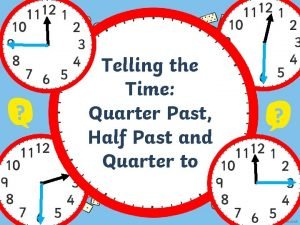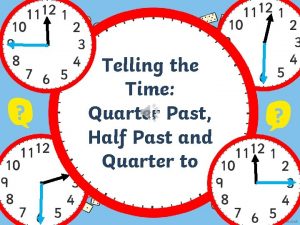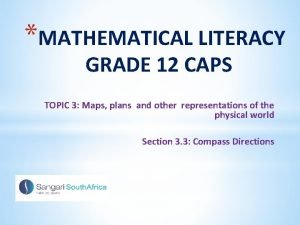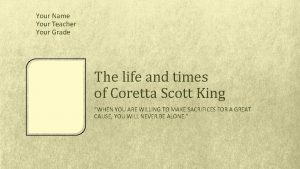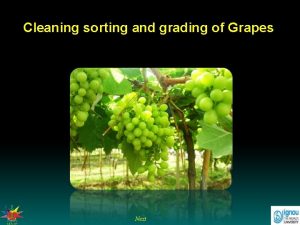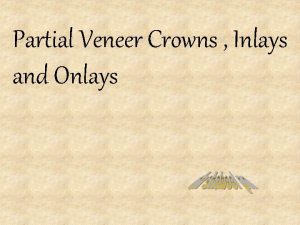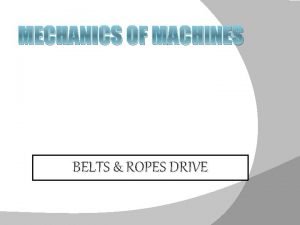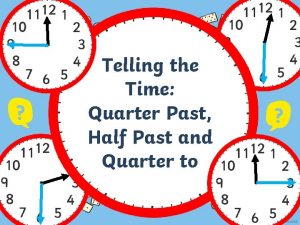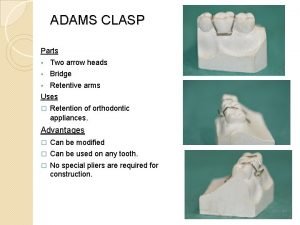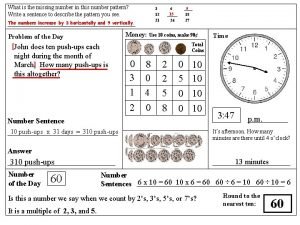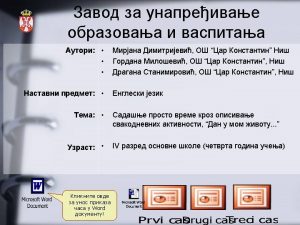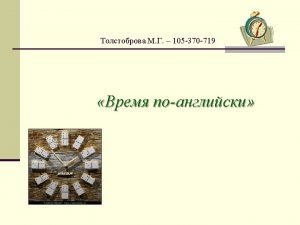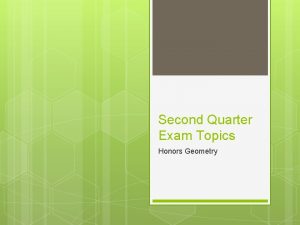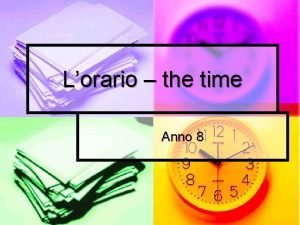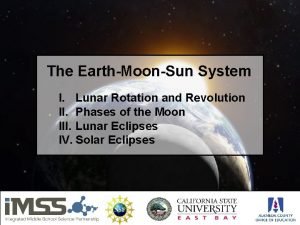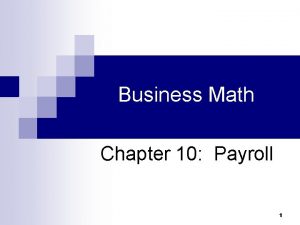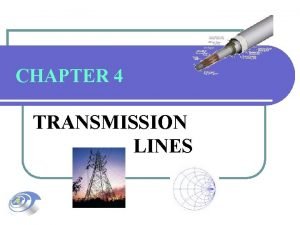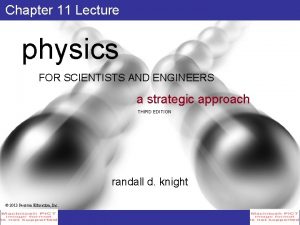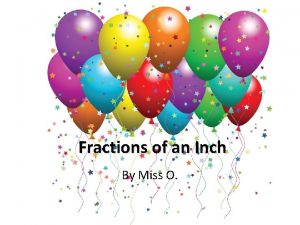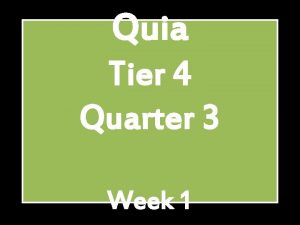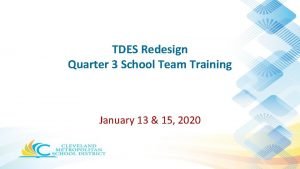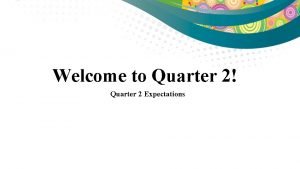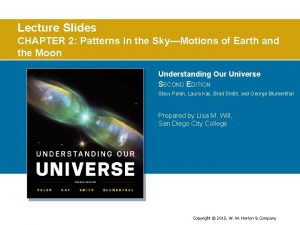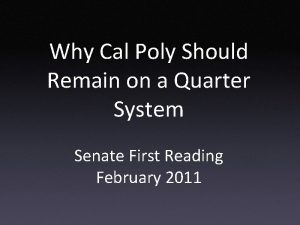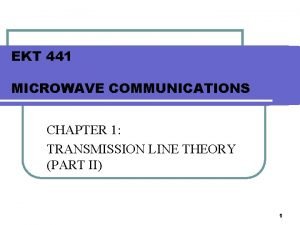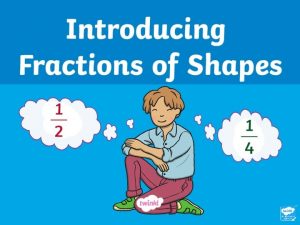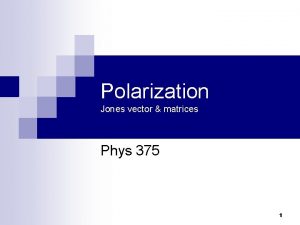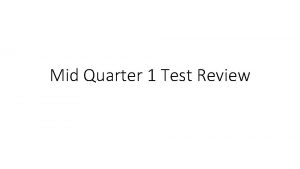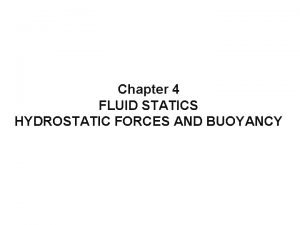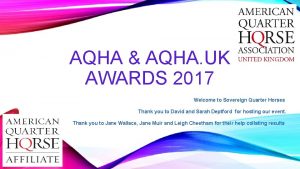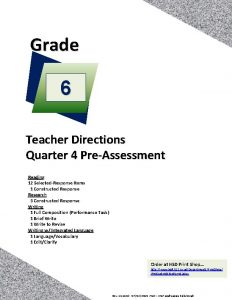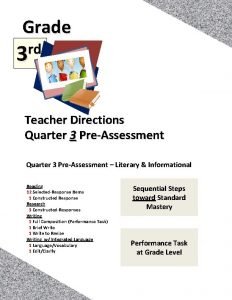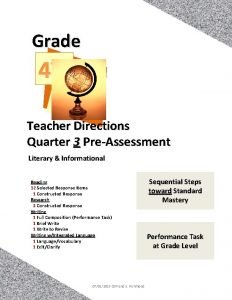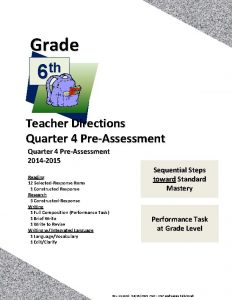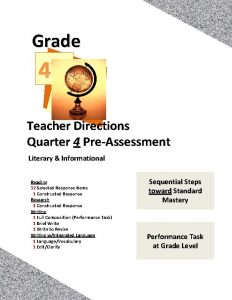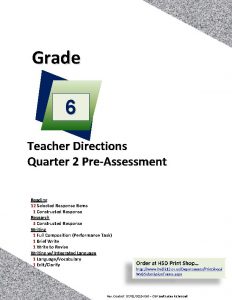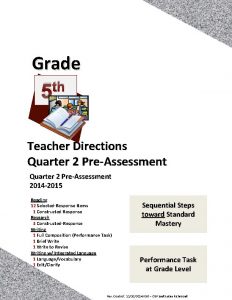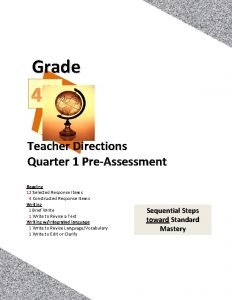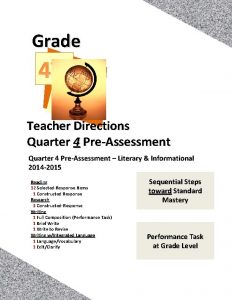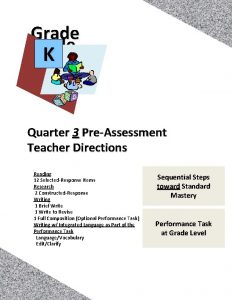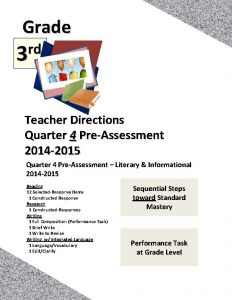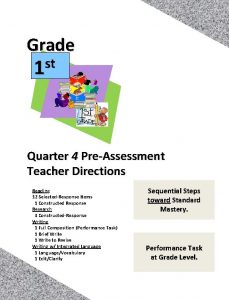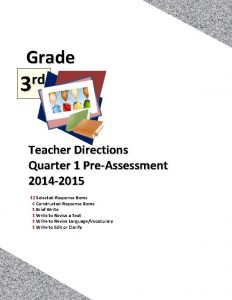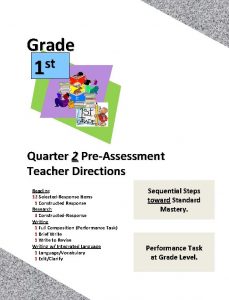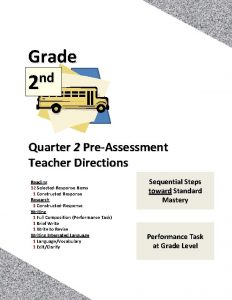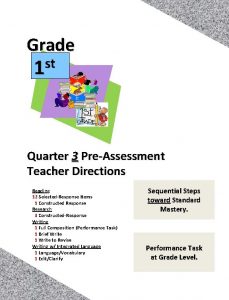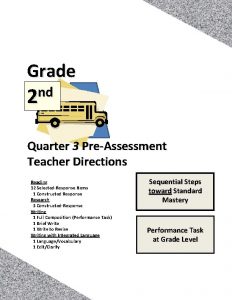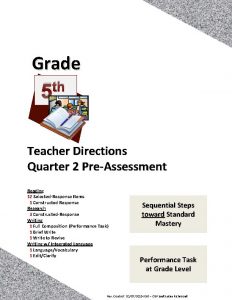Grade th 5 Teacher Directions Quarter 4 PreAssessment

















































- Slides: 49

Grade th 5 Teacher Directions Quarter 4 Pre-Assessment Reading 12 Selected-Response Items 1 Constructed Response Research 3 Constructed-Response Writing 1 Full Composition (Performance Task) 1 Brief Write 1 Write to Revise Writing w/ Integrated Language 1 Language/Vocabulary 1 Edit/Clarify Sequential Steps toward Standard Mastery Performance Task at Grade Level Rev. Control: 07/08/2015 HSD – OSP and Susan Richmond

th 5 Quarter Four Pre. Assessment Reading: Literature Grade Five Targets Standards DOK 3 Reasoning and Evidence RL. 3 1 -2 6 Reasoning and Evidence RL. 6 2 5 Analysis Within and Across Texts RL. 9 4 Reading: Informational Grade Five Targets Standards DOK 11 Reasoning and Evidence RI. 3 1 -2 11 Reasoning and Evidence RI. 6 3 12 Analysis Within and Across Texts RI. 9 4 Note: There may be more standards per target. Writing standards assessed are boxed. Opinion Writing and Language Targets Standards DOK 1 a Brief Opinion Write W. 1 a, W. 1 b, W. 1 c, W. 1 d 3 1 b Write-Revise Opinion W. 1 a, W. 1 b, W. 1 c, W. 1 d 2 2 Full Opinion Composition W-1 a, W-1 b, W-1 c, W-1 d, W-4, W-5, W-8 4 8 Language-Vocabulary Use W. 5. 2 d 1 -2 9 Edit and Clarify L. 5. 1 d 1 -2 Rev. Control: 07/08/2015 HSD – OSP and Susan Richmond

All elementary ELA assessments were reviewed and revised in June of 2015 by the following amazing and dedicated HSD K-6 th grade teachers. Deborah Alvarado Lincoln Street Ko Kagawa Minter Bridge Linda Benson West Union Jamie Lentz Mooberry Anne Berg Eastwood Sandra Maines Quatama Aliceson Brandt Eastwood Gina Mc. Lain TOSA Sharon Carlson Minter Bridge Teresa Portinga Patterson Deborah Deplanche Patterson Judy Ramer Consultant Alicia Glasscock Imlay Sara Retzlaff Mc. Kinney Sonja Grabel Patterson Jami Rider Free Orchard Megan Harding Orenco Kelly Rooke Free Orchards Renae Iversen TOSA Angela Walsh Witch Hazel Ginger Jay Witch Hazel Rev. Control: 07/08/2015 HSD – OSP and Susan Richmond 3

This is a pre‐assessment to measure the task of writing an opinion piece. Full compositions are always part of a Performance Task. A complete Performance Task would have: Part 1 • A classroom activity (30 Minutes) • Passages or stimuli to read • 3 research questions • There may be other constructed response questions. Part 2 • A Full‐Composition (70 Minutes) Students should have access to spell‐check resources but no grammar‐check resources. Students can refer back to their passages, notes and 3 research questions and any other constructed responses, as often they’d like. The note‐taking forms in this pre‐assessment were created for informational text. If you choose to use these, please have your students take notes while reading the informational passages. Directions 30 minutes 1. You may wish to have a 30 minute classroom activity. The purpose of a PT activity is to ensure that all students are familiar with the concepts of the topic and know and understand key terms (vocabulary) that are at the upper end of their grade level (words they would not normally know or are unfamiliar to their background or culture). The classroom activity DOES NOT pre‐teach any of the specific content that will be assessed! 35 minutes 2. Students read the passages independently. If you have students who can not read the passages you may read them to those students but please make note of the accommodation. Remind students to take notes as they read. During an actual SBAC assessment students are allowed to keep their notes as a reference. 3. Students answer the 3 research questions or other constructed response questions. Students should also refer to their answers when writing their full opinion piece. 15 minute break 70 Minutes 4. Students write their full composition (opinion piece). SCORING An opinion Rubric is provided. Students receive three scores: 1. Organization and Purpose 2. Evidence and Elaboration 3. Conventions Rev. Control: 07/08/2015 HSD – OSP and Susan Richmond 4

Dangerous! Or Not? (G 5 -Q 4 Pre) This classroom pre-activity follows the Smarter Balanced Assessment Consortium general design of contextual elements, resources, learning goals, key terms and purpose [http: //oaksportal. org/resources/] The content within each of these was written by Renae Iversen. The Classroom Activity introduces students to the context of a performance task, so they are not disadvantaged in demonstrating the skills the task intends to assess. Contextual elements include: 1. an understanding of the setting or situation in which the task is placed 2. potentially unfamiliar concepts that are associated with the scenario 3. key terms or vocabulary students will need to understand in order to meaningfully engage with and complete the performance task The Classroom Activity is also intended to generate student interest in further exploration of the key idea(s). The Classroom Activity should be easy to implement with clear instructions. Please read through the entire Classroom Activity before beginning the activity with students to ensure any classroom preparation can be completed in advance. Throughout the activity, it is permissible to pause and ask students if they have any questions. Resources needed: • T‐chart of characteristics of safety/danger (ancillary resources) • Chart paper or a place to display T‐chart so all students can see it. • Google slides presentation https: //docs. google. com/presentation/d/1 G 7 HGHty‐ 6 Hae. Bb 6 riz 8 t 2 T_r. MHVSp. Fq. A 0 t. Xq. S 3 FVPy. A/edit? usp=sharing • Scratch paper for students to take notes Learning Goals: 1. Students will understand the characteristics of danger and safety. 2. Students will use their opinions of danger/safety to debate whether a recreational activity is dangerous or safe. Students will understand the key terms: Note: Definitions are provided here for the convenience of facilitators. Students are expected to understand these key terms in the context of the task, not memorize the definitions. • • danger the possibility that something unpleasant or bad will happen safety‐ freedom from harm or danger opinion‐what someone thinks about a particular thing debate‐a discussion between people in which they express different opinions about something [Purpose: The facilitator’s goal is to help students know the difference between safety and danger and form opinions to debate the danger/safety of specific recreational activities. *Facilitators can decide whether they want to display ancillary materials using an overhead projector or computer/Smartboard, or whether they want to produce them as a handout for students. Rev. Control: 07/08/2015 HSD – OSP and Susan Richmond

Title: Dangerous! Or Not? (G 5 -Q 4 Pre) Facilitator says: Today we are going to talk about danger and safety. First, I want you to privately think about what makes something dangerous or safe. We will share with A/B partners in 1 minute. Facilitator says: [After identifying the A/B partners]. . . A partners share with the B partners about what makes something dangerous and what makes it safe. (1 minute). Now, switch and B partners share your thoughts with A partners. (1 minute) Facilitator says: [On chart paper/overhead/Smart. Board, etc. ]. . . Based on your discussion, we are going to fill out a Tchart together about the characteristics of safety and danger. [Facilitator takes answers about the characteristics of danger/safety and records them on the T‐chart for all students to see. Guide discussion as needed. ] Possible student responses (unscripted): ‐ It is dangerous if you might die. ‐ It is safe if you have safety equipment. ‐ It is dangerous if it can cause you harm. ‐ It is safe if you have proper gear to keep you protected. ‐ If it’s not as controlled, it can be dangerous. Facilitator says: Now I am going to show you some slides of recreational activities that could be dangerous or safe depending on your opinion. When we are finished looking at the slides we will be debating your opinions about the recreational activity. You may be asked to share the safety OR the danger of the activity shown on the slide so make sure you think about both sides. Take notes on scratch paper if you would like. [Share Power. Point of Dangerous Recreational Activities and read captions aloud: https: //docs. google. com/presentation/d/1 G 7 HGHty‐ 6 Hae. Bb 6 riz 8 t 2 T_r. MHVSp. Fq. A 0 t. Xq. S 3 FVPy. A/edit? usp=sharing ] [You may allow students to quietly discuss with table groups as you are viewing each slide. ] [There are 6 recreational activities shown on the slides. You will choose 12 students (or more if you’d like) to debate in front of the class. There will be one safety debater and one danger debater per slide (or more if you’d like). ] Facilitator says: After having seen the activities shown on the slides, I am going to choose 12 students who will be debating in front of the class. For each slide, one person will be debating about the safety of the activity shown and one person will be debating the dangers of the activity shown. You will have one minute each. Rev. Control: 07/08/2015 HSD – OSP and Susan Richmond

Title: Dangerous! Or Not? (G 5 -Q 4 Pre) [Facilitator assigns students to the recreational activity and whether they will debate the safety or danger of it. ] [Bring students up to the front one pair at a time. Show the slide of the activity being debated. Give each student 1 minute to share their opinion of the safety or danger (whichever one they were tasked with) of the assigned recreational activity on the slide. ] Facilitator says: “In your performance task, you will be learning about hot air balloons and forming an opinion about whether they are safe or dangerous. The group work you did today should help prepare you for the research and writing you will be doing in the performance task. ” Note: Facilitator should collect student notes from this activity. Rev. Control: 07/08/2015 HSD – OSP and Susan Richmond

Ancillary Materials for Dangerous! Or Not? (G 5‐Q 4 Pre) Dangerous Safe Rev. Control: 07/08/2015 HSD – OSP and Susan Richmond

Order at HSD Print Shop… http: //www. hsd. k 12. or. us/Departments/Print. Shop/ Web. Submission. Forms. aspx Directions The HSD Elementary assessments are neither scripted nor timed assessments. They are a tool to inform instructional decision making. It is not the intent of these assessments to have students “guess and check” answers for the sake of finishing an assessment. All students should “move toward” taking the assessments independently but many will need scaffolding strategies. If students are not reading at grade level and can’t read the text, please read the stories to the students and ask the questions. Allow students to read the parts of the text that they can. Please note the level of differentiation a student needed. About this Assessment This assessment includes: Selected‐Response, Constructed‐Response, and a Performance Task. Types of SBAC Constructed Response Rubrics in this Assessment http: //www. livebinders. com/play? id=774846 Reading • 2 Point Short Response • 2‐ 3 Point Extended Response Writing • 4 Point Full Composition Rubric (Performance Task) • 2‐ 3 Point Brief Write (1‐ 2 Paragraphs) Rubric • 2‐ 3 Point Write to Revise Rubrics as Needed Research • 2 Point Rubrics Measuring Research Skill Use Quarter 4 Performance Task The underlined sections are those scored on SBAC. Please take 2 days to complete performance tasks. Part 1 • • Part 2 Classroom Activity if Desired/Needed Read two paired passages. Take notes while reading (note‐taking). Answer SR and CR research questions about sources Components of Part 1 Note-Taking: Students take notes as they read passages to gather information about their sources. Students are allowed to use their notes to later write a full composition (essay). Note‐taking strategies should be taught as structured lessons throughout the school year in grades K – 6. A teacher’s note-taking form with directions and a notetaking form for your students to use for this assessment is provided, or you may use whatever formats you’ve had past success with Please have students practice using the note‐taking page in this document before the actual assessment if you choose to use it. Research: In Part 1 of a performance task students answer constructed response questions written to measure a student’s ability to use research skills needed to complete a performance task. These CR questions are scored using the SBAC Research Rubrics rather than reading response rubrics. • • Class Activity Plan your essay (brainstorming ‐pre‐writing). Write, Revise and Edit (W. 5) Writing a Full Composition or Speech Components of Part 2 Planning Students review notes and sources and plan their composition. Write, Revise and Edit Students draft, write, revise and edit their writing. Word processing tools should be available for spell check (but no grammar check). This protocol focuses on the key elements of writing opinion pieces: • Statement of Purpose/Focus: Do you clearly state your opinion? Do you stay on topic? • Organization: Do your ideas flow logically from the introduction to conclusion? Do you use effective transitions? • Elaboration of Evidence: Do you provide evidence from sources about your opinions and elaborate with specific information? • Language and Vocabulary: Do you express your ideas effectively? Do you use precise language that is appropriate for your audience and purpose? • Conventions: Do you use punctuation, capitalization and spelling correctly? There are NO Technology-enhanced Items/Tasks (TE) Note: It is highly recommended that students have experiences with the following types of tasks from various on-line instructional practice sites, as they are not on the HSD Elementary Assessments: reordering text, selecting and changing text, selecting text, and selecting from drop-down menu Rev. Control: 07/08/2015 HSD – OSP and Susan Richmond

Determining Grade Level Text Grade level text is determined by using a combination of both the CCSS new quantitative ranges and qualitative measures. Example: If the grade equivalent for a text is 6. 8 and has a lexile of 970, quantitative data shows that placement should be between grades 4 and 8. Common Core Band Flesch-Kincaid® The Lexile Framework® 2 nd - 3 rd 1. 98 - 5. 34 420 - 820 4 th - 5 rd 4. 51 - 7. 73 740 - 1010 6 th – 8 th 6. 51 - 10. 34 925 - 1185 9 th – 10 th 8. 32 - 12. 12 10. 50 - 1335 11 th - CCR 10. 34 - 14. 20 11. 85 - 1385 Four qualitative measures can be looked at from the lower grade band of grade 4 to the higher grade band of grade 8 to determine a grade level readability. Rate your text from easiest to most difficult between bands. 4 Qualitative Factors Beginning of lower (band) grade End of lower (band) grade Beginning of higher (band) to mid End of higher (band) grade Purpose/Meaning Structure Language Clarity Language Overall Placement The combination of the quantitative ranges and qualitative measures for this particular text shows that grade 6 would be the best readability level for this text. To see more details about each of the qualitative measures please go to slide 6 of: http: //www. corestandards. org/assets/Appendix_A. pdf Rev. Control: 07/08/2015 HSD – OSP and Susan Richmond Not suited to band

Pre-Assessment and Learning Progressions The pre-assessments are unique. They measure progress toward a standard Unlike the Common Formative Assessments which measure standard mastery, the pre‐assessments are more like a base‐line picture of a student’s strengths and gaps, measuring skills and concepts students need “along the way, ” in order to achieve standard mastery. END of Beg. of QTR CFA Example of a Learning Progression for RL. 2. 1 Pre‐Assessments Measure Adjustment Points (in purple) RL. 2. 1 grade -level standard assessment. After the pre‐assessment is given, Learning Progressions provide informal formative assessment below and near grade-level “tasks” throughout each. Throughout quarter. DOK 1 - Ka Recall who, what, where, when, why and how about a story read and discussed in class. DOK - Kc Use and define Standard Academic Language: who, what, where, when, why, and how; ask, answer, questions, key details DOK 1 - Cd Connect the terms who to characters; where and when to setting; what and how to sequence of events. DOK 1 - Cf Ask and answer who, what, where, when, why and how questions about key details in a text. the QTR DOK 2 - Ch Concept Development Student understands that key details help tell who, what, where, when, why and how. DOK 2 - Ck Uses key details to identify who, what, where, when, why and how about a story not read in class. QTR DOK 2 -Cl Finds information using key details to answer specific questions about a new story. Standard Mastery RL. 2. 1 Ask and answer such questions as who, what, where, when, why, and how to demonstrate understanding of key details in a text So what about a “post‐assessment? ” There is not a standardized post‐assessment. The true measure of how students are doing “along the way, ” is assessed in the classroom during instruction and classroom formative assessment. For this reason The CFA’s are not called “post‐assessments. ” The CFAs measure the “end goal, ” or standard mastery. However, without the pre‐assessments, how will we know what our instruction should focus on throughout each quarter? Learning Progressions: are the predicted set of skills needed to be able to complete the required task demand of each standard. The learning progressions were aligned to Hess’ Cognitive Rigor Matrix. The pre‐assessments measure student proficiency indicated on the boxes in purple (adjustment points). These points are tasks that allow us to adjust instruction based on performance. For instance, if a student has difficulty on the first “purple” adjustment point (DOK‐ 1, Cf) the teacher will need to go back to the tasks prior to DOK‐ 1 Cf and scaffold instruction to close the gap, continually moving forward to the end of the learning progression. There is a Reading Learning Progression checklist for each standard in each grade that can be used to monitor progress. It is available at: http: //sresource. homestead. com/Grade‐ 2. html Rev. Control: 07/08/2015 HSD – OSP and Susan Richmond 11

Quarter Four Reading Literature Learning Progressions. The indicated boxes highlighted before the standard, are assessed on this pre‐assessment. The standard itself is assessed on the Common Formative Assessment (CFA) at the end of each quarter. DOK 1 - Ka Recalls specific details in a story or drama about characters, settings or events (read and discussed in class). DOK 1 - Kc Define and understand Standard Academic Language: literary elements, (characters, setting, plot, events, etc. ), compare and contrast, drama, specific details and interactions. DOK 1 - Cd Describe specific details about two or more characters, settings or events in ONE story or drama (read and discussed in class). DOK 1 - Cf Answer describing who, what, when, where or how questions about two or more characters, settings or events in ONE story or drama (read and discussed in class). DOK 2 - Ch Concept Development Understands that characters, settings and events within one story or drama can be compared and contrasted. DOK 2 - Cl Locates specific descriptive details that compare or contrast setting, events or characters (refer to compare and contrast language clues). DOK 2 - ANp Categorize details that compare and contrast two or more characters, setting or events using a graphic organizer (new text). DOK 3 - Cu Connect ideas about 2 characters, setting or events. What details make them similar/different ? Explain and support with textual evidence (new text). Standard RL 5. 3 Compare and contrast two or more characters, settings, or events in a story or drama, drawing on specific details in the text (e. g. , how characters interact). DOK 1 - Ka DOK 1 - Kc DOK 1 - Cd DOK 1 - Cf DOK 2 - Ch DOK 2 - Cl DOK 3 - Cu DOK 4 - ANQ DOK 4 - EVS Recall basic facts or events from a narration read or discussed in class. Define and Understand the meaning of the Standard Academic Language : speaker, narrator, point of view, influences Identify and describe the characters, setting and sequence of events. Identify characters who are speaking (in a text read and discussed) Answer questions that identify a character’s point of view. Concept Development Understands that points of view may influence how events are described. Locate information to identify which character is speaking in the first person or third person. Use text evidence to explain a character’s point of view. Use speaker’s discourse style to help understand their point of view. Justify reasoning behind speaker’s discourse style and how it influences their point of view. DOK 1 - Ka Recall or locate basic information in stories of the same genre regarding events and specific details (read and discussed in class). DOK 2 ANt Categorize Distinguish (list on a between graphic) genres by approaches to identifying themes and characteris topics noted tics. in stories of the same genre. DOK 2 - ANp DOK 1 - Kc Understands and uses Standard Academic Language terms: compare and contrast, genre, mysteries, adventures, approaches, similar ‐ theme and topic. DOK 3 - ANz Compare and contrast theme and topic approaches within the same genre. Use a graphic organizer to note similarities and differences (Venn). SELECTED RESPONSE DOK 1 - Cd Identify similarities of characters, setting, and event sequence in stories of the same genre. DOK 1 - Cf Answers basic questions about how stories with similar themes or topics (read and discussed in class) are introduced and conclude. DOK 3 - EVE Share results of comparing and contrasting how different genres approach a theme or topic. Verify the reasonableness of the results during discussion or presentation. DOK 2 - Ch Concept Development: Understands that different genre can approach themes and topics differently (mysteries approach the plot early, adventures approach exciting risks early on). DOK 2 - Ci Summarize events in stories of the same genre (introduction, development and conclusion). Discuss how each story has a similar approach to a topic or theme based on the genre type. DOK 4 – Standard SYV RL 5. 6 Describe how a narrator’s or speaker’s point of view influences how events are described. DOK 2 - Ck Make generalizations about how to recognize stories of the same genre (What story elements do you see in most mysteries? Adventures? ) DOK 3 - SYH DOK 4 - CL DOK 4 - SYU Standard Synthesize information within one text about how it approaches a theme or topic. What influence did genre play? SELECTED RESPONSE Develop (write) the generalized results of how specific genres approach a theme or topic. Apply this generalization to new texts (not read or discussed in class). Does the generalization apply to all? Compare and contrast multiple stories of the same genre using evidence gathered, generalizations, any graphics used, etc… Conclude with a statement or section about approaches to themes and topics. CONSTRUCTED RESPONSE RL 5. 9 Compare and contrast stories in the same genre (e. g. , mysteries and adventure stories) on their approaches to similar themes and topics. Rev. Control: 07/08/2015 HSD – OSP and Susan Richmond 12

Quarter Four Reading Informational Learning Progressions. The indicated boxes highlighted before the standard, are assessed on this pre‐assessment. The standard itself is assessed on the Common Formative Assessment (CFA) at the end of each quarter. DOK 1 - Ka Recall or locate specific information in a historical, scientific or technical text (read and discussed in class). DOK 1 - Ka Recall basic facts about a topic or event from multiple accounts (read and discussed in class). DOK 1 - Kc DOK 1 - Cf Define and understand Standard Academic Language: relationships, interactions, evidence (to support ideas), historical, scientific, technical texts and phrase “between 2 or more. ” DOK 1 - Kc Define and Understand the meaning of the Standard Academic Language: point of view, bias, similarities, differences, events, topics, evidence, multiple accounts and represent. DOK 2 - Ch Answer who, what, when, where and how questions about individuals, events, ideas or concepts based on specific information in a historical, scientific or technical text (read and discussed in class). DOK 1 - Cf Answer specific who, what, when, where or how questions about the same topic or event from multiple accounts (read but the questions have not been discussed in class). Concept Development Explains and understands how individuals, events, ideas or concepts can interact in text. DOK 2 - Ch Concept Development Understands and recognizes that multiple accounts may have different points about the same topic DOK 2 - Cl Locate specific information to support how two individuals interact in a text (continue with events, ideas or concepts), (rea d but not discussed in class). DOK 2 - Cl Find examples of specific points in multiple accounts. DOK 3 – Cu (taught in several lessons) Explain the Use the text connection to explain between two between the or more two or more relationships individuals or events or or events in an ideas in a interactions historical scientific between text. ideas, individuals or events within one text. DOK 2 - ANp Categorize specific points from multiple accounts with similar points of view (no contrasting at this point, just comparing). DOK 3 - EVE Verify the reasonablen ess of how specific points from multiple texts are presented (are the points valid? ). DOK 1 - Kc DOK 1 - Cf DOK 2 - Ch DOK 2 - Cl DOK 2 - ANp DOK 2 - ANs Standard Using specific information a text, analyze the interrelations hips between concepts, ideas, events or individuals. RI 5. 3 Explain the relationships or interactions between two or more individuals, events, ideas, or concepts in a historical, scientific, or technical text based on specific information in the text. DOK 4 - ANN Analyze (compare and contrast) multiple accounts of the same event or topic, noting important similarities and differences in the point of view they represent (venn). DOK 4 CK Recall basic Understand Answer Concept Locate Make lists or Using a provided A student Student facts about and use specific who, Developm specific categories prompt about a provides explains a topic or Standard what, when, ent: examples of (graphs) of topic, student an why topic event from Academic where or Student information similar determines what explanatio concepts several Language how understand from several information is relevant or not n of how are texts (read accurately: questions s that to texts on the found in to the prompt ideas were interrelat and Integrate, about the obtain a same topic several texts using several selected ed across discussed topic, same topic complete following a about the sources (planning, for several in class). knowledgeabl or event idea of a teacher’s same topic. graphic relevance texts y and topic from several topic they prompt. SELECTED organizers). in a justifying specific texts read need to RESPONSE SELECTED graphic their vocabulary and integrate RESPONSE organizer selections related to the discussed in informatio about a of subject area. class. n from specific relevant several topic/pro informati sources. mpt on about a topic. DOK 1 - Ka DOK 3 - ANz DOK 3 - Cu DOK 4 - SYV Synthesize specific points across multiple texts on the same event or topic to articulate a new perspective. Standard RI 5. 6 Analyze multiple accounts of the same event or topic, noting important similarities and differences in the point of view they represent. DOK 4 – SYU Standard Gather and RI 5. 9 Integrate organize topic information specific from several information from texts on the multiple texts for same topic in a purpose (essay order to write or or speech) to speak about the speak subject knowledgeably about a topic. CONSTRUCTED RESPONSE DOK 4 - ANP Rev. Control: 07/08/2015 HSD – OSP and Susan Richmond 13

Grade 5 Research Notes Teacher Guide R E- S E A R SOMETHING NEW EXPLAIN MORE AGAIN and AGAIN RELEVANT OR NOT? C CONCLUDE H HAVE EVIDENCE What problems or questions does the author state about the main idea? students to re-read and selectthe a paragraph Write one new problem or question the author brings to. Instruct the reader’s attention about main or section of the text with problems or questions topic. about the main topic. Ask, “Does the section or paragraph you chose state _______________________________________ a new question or problem about the main idea? ” idea This is a key detail that may help solve the problem _______________________________________ or answer the question (be sure students can identify the main topic). ” Key Details Have students write ONE brief sentence about a new problem or question the author brings to the from the passage explain more about the problem orabout question? reader’s attention the main idea. What key details Write two key details that provide an answer or a solution. Use Quotes from the text when possible. 1 • Key Detail (has an answer or solution) Ask students to look for key details that explain ____________________________________ more about the problem or question. Remember students will need to have a note-taking form Explain “Key details about the main idea can help for ____________________________________ each passage. us find answers to a question or solution to a problem. ” problem Instruct students to write 2 brief key details that provide an answer or solution 2 • Key Detail (has an answer or solution) _________________________________________________________________________ Again and Again What words, phrases or ideas does the author use again. Instruct and again? Write students to lookthem at thehere. again and again Think about why the author uses them again and again. words or phrases, ask “Do you see some of the Have students re-read the paragraph or section they wrote about and write words or ideas they see Again and Again, Again in the box. Explain, “When author’s use the same words, phrases or ideas Again and Again ask yourself “why? ” It means something is important. ” again and again words or ideas in the key details about problems and solutions? Can the words help you write one conclusion sentence that summarizes the problem and solution (or the question and answer)? ” answer) 3 Summarizing is a big part of writing conclusions. It is an extremely important strategy for students to learn in order to use research skills effectively. 4 Differentiation: Students whothat need more pages –the print as many as needed. Students would benefit from enrichment can continue on with more sections or Write one conclusion sentence tells most about thewhonew contribution (key idea). paragraphs. Students who need more direct instruction – teach part as a mini lesson. These concepts can be taught separately: • Main Topic Use some of the again and again words or ideas in your summary. • Problem/solution question/answer • Key Details ______________________________________ • Again and Again • Conclusions - Summarizing ELL Students may need each part taught using language (sentence) frames emphasizing transitional words. _______________________________________ Rev. Control: 07/08/2015 HSD – OSP and Susan Richmond

Grade 5 Research Notes RE S SOMETHING NEW E EXPLAIN MORE A AGAIN & AGAIN R RELEVANT OR NOT? C CONCLUDE H HAVE EVIDENCE Name________ Passage_______ Main Idea________ What problems or questions does the author state about the main idea? Write one new problem or question the author brings to the reader’s attention about the main idea. _____________________________________________________________________________ Key Details What key details from the section or paragraph explain more about the problem or question? Write two key details that provide an answer or a solution. Use quotes from the text when possible. • Key Detail (has an answer or solution) _________________________________________________________________________ Again and Again What words, phrases or ideas does the author use again and again? Write them here. Think about why the author uses them again and again. Write one conclusion sentence that tells the most about the new key idea and the answer and solution key details. Use some of the again and again words or ideas in your summary. _____________________________________________________________________________ Rev. Control: 07/08/2015 HSD – OSP and Susan Richmond

Grades 3 - 5: Generic 4 -Point Opinion Writing Rubric Statement of Purpose/Focus and Organization Score Statement of Purpose/Focus CCSS and Report Card Alignment Text Types & Purposes: 3 rd-W. 3. 1 a-c 4 th-W. 4. 1 a-c 5 th-W. 5. 1 a-c The response is fully sustained and consistently and purposefully focused: 4 Exemplary (E) • opinion is clearly stated, focused, and strongly maintained • opinion is communicated clearly within the context The response is adequately sustained and generally focused: 3 Proficient (M) 2 Developing (NM) 1 Merging (NY) • opinion is clear and The response is somewhat sustained with some extraneous material or a minor drift in focus: • may be clearly focused on the opinion but is insufficiently sustained • opinion on the issue may be unclear and unfocused The response may be related to the purpose but may offer little or no focus: • may be very brief • may have a major drift confusing or ambiguous Elaboration of Evidence Language and Vocabulary CCSS and Report Card Alignment Research to Build and Present Knowledge: 3 rd-W. 3. 7 -8 4 th-W. 4. 7 -9 5 th-W. 5. 7 -9 CCSS and Report Card Alignment Conventions & Vocab. Acquisition: 3 rd-L. 3. 1 b-i, L. 3. 3 a & L. 3. 6 4 th-L. 4. 1, L. 4. 3 a, & L. 4. 6 5 th-L. 5. 1 b-e, L. 5. 3 a & L. 5. 6 The response has a clear and effective organizational structure creating unity and completeness: The response provides thorough and convincing support/evidence for the writer’s opinion that • effective, consistent use of a includes the effective use variety of transitional of sources, facts, and strategies details: • logical progression of ideas from beginning to end • effective introduction and conclusion for audience and purpose The response has an recognizable organizational structure, though there may be minor flaws and some ideas may be loosely connected: for the most part maintained, though • adequate use of transitional some loosely related strategies with some variety material may be • adequate progression of present ideas from beginning to end • context provided for • adequate introduction and the claim is adequate conclusion • opinion may be 0 Organization CCSS and Report Card Alignment Text Types & Purposes: 3 rd-W. 3. 1 c-d 4 th-W. 4. 1 c-d 5 th-W. 5. 1 c-d Development: Language and Elaboration of Evidence The response has an inconsistent organizational structure, and flaws are evident: • inconsistent use of transitional strategies with little variety • uneven progression of ideas from beginning to end • conclusion and introduction, if present, are weak • use of evidence from sources is smoothly integrated, comprehensive, and relevant • effective use of a variety of elaborative techniques The response provides adequate support/evidence for the writer’s opinion that includes the use of sources, facts, and details: • some evidence from sources is integrated, though citations may be general or imprecise • adequate use of some elaborative techniques The response provides uneven, cursory support/evidence for the writer’s opinion that includes partial or uneven use of sources, facts, and details: • evidence from sources is may intrude The response clearly and effectively expresses ideas, using precise language: • use of academic and domain‐specific vocabulary is clearly appropriate for the audience and purpose The response demonstrates a strong command of conventions: The response adequately expresses ideas, employing a mix of precise with more general language: The response demonstrates an adequate command of conventions: • use of domain‐specific vocabulary is generally appropriate for the audience and purpose • few, if any, errors in usage and sentence formation e • effective and consistent use of punctuation, capitalization, and spelling • some errors in usage and sentence formation are present, but no systematic pattern of errors is displayed • adequate use of punctuation, capitalization, and spelling The response expresses The response ideas unevenly, using expresses ideas simplistic language: unevenly, using • use of domain‐specific simplistic language: vocabulary that may at times be inappropriate for the audience and purpose weakly integrated, and citations, if present, are uneven • weak or uneven use of elaborative techniques The response has little or no The response provides discernible organizational minimal support/evidence structure: for the writer’s opinion • few or no transitional that includes little or no strategies are evident use of sources, facts, and • frequent extraneous ideas details: Conventions CCSS and Report Card Alignment Conventions: 3 rd-L. 3. 2 4 th-L. 4. 2, L. 4. 3 b 5 th-L. 5. 2 The response expression of ideas is vague, lacks clarity, or is confusing: • uses limited language or domain‐specific vocabulary • use of evidence from sources is minimal, absent, • may have little sense of audience and purpose in error, or irrelevant • use of domain‐specific vocabulary that may at times be inappropriate for the audience and purpose The response demonstrates a lack of command of conventions: • errors are frequent and severe and meaning is often obscured A response gets no credit if it provides no evidence of the ability to [fill in with key language from the intended target]. Rev. Control: 07/08/2015 HSD – OSP and Susan Richmond

Listening & reading Productive modalities*: Ways in which students communicate to others (e. g. , speaking, writing, and drawing). Instruction and assessment of productive modalities focus on students’ communication of their own understanding or interpretation. Interactive modalities*: Collaborative use of receptive and productive modalities as “students engage in conversations, provide and obtain information, express feelings and emotions, and exchange opinions” (Phillips, 2008, p. 3). Standard An ELL can… Speaking & Writing Listening, speaking, reading, and writing Productive (S & W) 1 construct meaning from oral presentations and literary and informational text through grade‐appropriate listening, reading, and viewing 8 determine the meaning of words and phrases in oral presentations and literary and informational text 3 speak and write about grade‐appropriate complex literary and informational texts and topics 4 construct grade-appropriate oral and written claims and support them with reasoning and evidence 7 adapt language choices to purpose, task, and audience when speaking and writing 2 participate in grade-appropriate oral and written exchanges of information, ideas, and analyses, responding to peer, audience, or reader comments and questions 5 conduct research and evaluate and communicate findings to answer questions or solve problems 6 analyze and critique the arguments of others orally and in writing By the end of an English language proficiency level, an ELL in grades 4 -5 can. . . 1 4 10 - make accurate use of standard English to communicate in grade‐appropriate speech and writing Receptive modalities*: Ways in which students receive communications from others (e. g. , listening, reading, viewing). Instruction and assessment of receptive modalities focus on students’ communication of their understanding of the meaning of communications from others. 9 - create clear and coherent grade-appropriate speech and text ELP 4 th – 5 th Grade Band Standards Organized by Modality …express an …construct grade- opinion about a appropriate oral familiar topic. and written claims and support them with reasoning and evidence. 2 3 …construct a simple claim about a familiar topic, and give a reason to support the claim. …construct a claim about familiar topics, introducing the topic and providing a few reasons or facts to support the claim. 4 …construct a claim about a variety of topics: introduce the topic, provide several reasons or facts to support the claim, and provide a concluding statement. 5 …construct a claim about a variety of topics: introduce the topic, provide logically ordered reasons or facts to support the claim, and provide a concluding statement. This performance task is based on writing. As an option if you’d like to monitor growth for ELP as a second goal, teachers can choose to assess ELP standard 4 because it aligns with this specific performance task. Your student’s full composition can be analyzed to identify English language proficiency levels. It is evident that students will be navigating through the modalities to get to the end product. However, it is important to keep in mind what the full opinion writing performance task is assessing and how deeply the student understands class content and language. The ELP growth goal is to provide the “just‐right scaffolds” for students to demonstrate their understanding in order for them to move from one proficiency level to the next. Rev. Control: 07/08/2015 HSDAligned – OSP and Richmond Oregon ELP Standards with Susan Performance Task, 2014; Arcema Tovar

Opinion Writing Pre-Assessment Student and Class Scoring: Scoring Key: Total # Correct 1 = Emerging 0‐ 4 2 = Developing 3 = Proficient 4 = Exemplary 5‐ 7 8 ‐ 10 School Year: Grade: Teachers Name: School: 11 ‐ 12 Student Name: Focus and Organization Score Elaboration and Conventions Evidence Score Student Total Score 1. 2. 3. 4. 5 0 6 0 7 0 8 0 9 0 10 0 11 0 12 0 13 0 14 0 15 0 16 0 17 0 18 0 19 0 20 0 21 0 22 0 23 0 24 0 25 0 26 0 27 0 28 0 29 0 30 0 31 0 32 0 33 0 34 0 35 0 Rev. Control: 07/08/2015 HSD – OSP and Susan Richmond ELP Score

A Note about constructed responses: Constructed response answers are not written “in stone. ” There is no perfect way a student should respond. Look for the general intent of the prompt and student response and follow the rubric below as much as possible. Use your best judgment. Unlike DOK-1 questions where there is one right and wrong answer, constructed responses are more difficult to assess. Overall consistency of intent based on most of your student responses can guide you. Quarter 4 Pre-Assessment Research Constructed Response Answer Key Constructed Response Research Rubrics Target 3 Evidence of the ability to distinguish relevant from irrelevant information such as fact from opinion. Question #7 RL. 5. 6 Prompt: What are two examples of how the story, “ Jordan’s Ride” is told in the third-person point of view? Rewrite both examples as a first-person point of view. Explain how rewriting the examples affect the story for the reader. Teacher /Rubric “Language Response” The response gives sufficient evidence of the ability to distinguish relevant from irrelevant information. The student must first be able to distinguish relevant examples of characteristics of third‐person point of view from the story “Jordan’s Ride “and then be able to translate those same examples into a first‐person point of view. This is actually quite complex. Part 1: Examples from the story “Jordan’s Ride” of third‐person point of view characteristics could include (1) The narrator is telling “about” the character in the statement “Jordan woke up bright and early. ” The first person “translation” could read “I woke up bright and early, ” as if told by Jordan himself. Examples where students are replacing any reference to Jordan (i. e. his name or when Jordan is referred to: he, his, with “I, ”) are acceptable. (2) Replacing the use of “they, ” with “we” in reference to Jordan, mom and dad such as in the sentence “When it was time to land they slowly descended to the same grassy field they had left behind. ” Note: There could be many more examples and any third-person examples are acceptable if taken from the text. Part 2: Explaining how the first‐person point of view changes the “feel” of the story is very subjective to the reader but students should give examples that pertain to (1) the character is now telling his own story, (2) the story feels more personal and (3) the story may feel as if the reader could walk right into the character’s shoes. Student “Language” Response Example Student response gives evidence of finding two relevant third-person point of view statements that are re-written as first-person point of view statements. Student is then able to explain how the change in point of view affect the story. 2 In the story “Jordan’s Ride “(paragraph 4), the narrator states: “Jordan couldn’t believe it!” This is a third‐ person point of view – like someone looking on from the outside. To change this to a first‐person point of view it would read: “I couldn’t believe it!” Another examples of a third‐person point of view statement in the story (paragraph 5) is : “They spent about an hour soaring above the city. ” To change this to a first‐ person point of view it would read: “We spent about an hour soaring above the city. ” In the first‐person point of view if Jordan is saying “I couldn’t believe it”! the reader feels closer to Jordan because Jordan is speaking for himself and it feels personal. If the story was written in first‐person point of view and Jordan were to say “We spent about an hour soaring above the city, ” I would feel like I was right there with him. Student response gives some evidence of finding two relevant third-person point of view statements but does not rewrite as first-person point of view statements. Student has difficulty explaining the difference. 1 0 When a story tells about someone like they said or he said that is third‐person. The first person in the story is not really telling his own story. Its like being spied on and someone else is telling your story. For example the story said Jordan woke up bright and early. It should say Jordan said he woke up bright and early. That is first person because Jordan said it. It makes the story more interesting. Student response gives little or vague evidence of being able to find third person point of view examples from the text. I can write a story in first person or third person point of view. If I write a story about my friend that is third person point of view. Toward RL. 5. 6 DOK 4 - EVS Justify reasoning behind speaker’s discourse style and how it influences their point of view. Rev. Control: 07/08/2015 HSD – OSP and Susan Richmond 19

Quarter 4 Pre-Assessment Constructed Response Answer Key Standard RL. 5. 9 Point Reading Constructed Response Rubric Question #8 RL. 5. 9 Prompt: Why does “Jordan’s Ride” and “Macy’s Report”, develop theme of riding in a hot-air balloon differently? Support your conclusion with examples from both texts. Teacher Language and Scoring Notes: Sufficient Evidence to support the prompt would be in the form of comparable examples between “Jordan’s Ride” and “Macy’s Report” to determine why each story develops theme of experiencing a hot‐air balloon ride differently and stating why. Specific identifications (supporting details) would be within any examples from Jordan’s Ride could include (1) seeing a balloon expand, (2) having a pilot, (3) going into a basket, (4) rising and feeling scared, (5) feeling like flying, and (6) the view from above. Details within examples from “Macy’s Report” could include (1) mom explaining that heated air causes a balloon to rise, (2) dad telling her about a pilot, (3) learning about three main parts of a balloon, (4) steering a balloon, (5) the blast valves moving hot air, (6) the regulator letting air out to lower a balloon, (7) the direction of the wind determines where you go, (7) going for a ride in a balloon. Full Support could include (other details) any other details or examples specifically from the text that logically support the prompt. The student gives a proficient response by giving many examples of how both texts are developed and why. 3 I think each story develop theme of riding in a hot‐air balloon differently because each story is telling about hot‐air balloons for different reasons. For example in “Jordan’s Ride”, his parents are giving him a birthday surprise of going in a hot‐air balloon. In the story “Macy’s Report” her parents also surprise her with a ride in a hot‐air balloon but for the reason of helping her write a better report about hot‐air balloons. Jordan tells about what it feels like in a hot‐air balloon. He says he feels the balloon rising, he is scared and then he feels like they are flying. He describes what he can see from above and how happy he was to have had the experience. The story “Jordan’s Ride” develops theme of actually experiencing a hot‐air balloon ride (how it feels and looks). In the story “Macy’s Report” Macy has to write a report about the hot‐air balloon as a means of transportation. To write her report Macy studies hot‐air balloons at the library and on the internet. Macy learns how a balloon works (the scientific parts) and studies hot‐air balloons more for scientific reasons than just for fun. The story “Macy’s Report” develops theme of hot‐air balloons from a scientific view (how a hot‐air balloon works) rather than how it feels and looks. The student gives a sufficient response by giving some examples of how both texts are developed and why. 2 1 0 Jordan gets to ride in a balloon for his birthday. It’s a big surprise. The story tells how much he likes it. Jordan says it feels like flying even. So this story is all about what it feels like to be in a hot‐air balloon. But when you read “Macy’s Report” it’s not about just having fun going up in a balloon. She has to learn how balloons work and why for a report. So this story has a lot about how a hot‐air balloon really works like science words (valves, blasts and envelope). But Macy does get to finally go up in a balloon too. So the stories are different for a reason. One is for fun. One is for learning facts. The student gives a minimal response by giving examples of how both texts are developed and why. “Jordan’s Ride” is how it is in a balloon. “Macy’s Report” is about writing a book report for class. I liked both of the stories. The student does not give a response using examples of how both texts are developed or why. Riding in a hot‐air balloon is a lot of fun. It is like “Wheee!” I would love to try it and tell how much fun it is and why I rode in one. Toward RL. 5. 9 DOK 4 - SYU Compare and contrast multiple stories of the same genre using evidence gathered, generalizations, any graphics used, etc… Conclude with a statement or section about approaches to themes and topic. 20 Rev. Control: 07/08/2015 HSD – OSP and Susan Richmond

Quarter 4 Pre-Assessment Research Constructed Response Answer Key Constructed Response Research Rubrics Target 2 Locate, Select, Interpret and Integrate Information. Question #15 RI. 5. 6 Prompt: In what ways are the articles “How a Hot-Air Balloon Works” and “Adventure on a Hot Air Balloon, ” similar and different? Use evidence from both articles to support your answers. Teacher /Rubric “Language Response” The response gives sufficient evidence of the ability to locate and select information about the prompt. Students must locate and then select similarities and differences in the information from both articles in order to answer the prompt. The response gives sufficient evidence of the ability to interpret and integrate information about the prompt as students integrate the similarities and differences into one response. Student responses that indicate this ability include evidence from both articles. Similarities between the two articles could include: (1) both articles give information of how a hot air balloon rises and falls and (2) both explain how the pilot is able to move it when it is in the air. Differences between the two articles could include: (1)” How a Hot Air Balloon Works” provides more detailed information of the parts of a hot air balloon and how they work and (2) “Adventure on a Hot Air Balloon” is an example of how a real pilot handled his balloon in a crisis. Any information provided that is taken directly from either article and supports the prompt is acceptable. Student “Language” Response Example Student gives detailed examples of similarities and two examples of differences between the two articles with supporting evidence. 2 The two articles about hot air balloons have some similarities and some differences. They are similar because they both have information about how a hot air balloon works. For example “Adventures on a Hot Air Balloon” tells about what a pilot did to make his hot‐air balloon rise. He released propane from a tank so it would catch on fire. This made his balloon rise. The article “ How a Hot Air Balloon Works, ” also explains how to move a balloon upward using propane. Both articles also explain how to make a hot air balloon move downward. The main differences between the two articles is that one is written from the viewpoint of what its really like to go up into a hot air balloon, while the other article is written to learn about how to control a balloon. For example, the pilot in Adventures on a Hot Air Balloon, explains what he did to land his balloon at Wal‐Mart. Student gives examples that have very limited details of similarities and differences and limited supporting evidence. 1 The two articles were about how to make a hot air balloon work. One was like a textbook that explained how to do something. The other article was about a man who flew a hot air balloon. It was about his experiences and what it was like. 0 Student does not answer the prompt. The stories were about balloons. Toward RI. 5. 6 DOK 4 - SYV Synthesize specific points across multiple texts on the same event or topic to articulate a new perspective. Rev. Control: 07/08/2015 HSD – OSP and Susan Richmond 21

Quarter 4 Pre-Assessment Research Constructed Response Answer Key Constructed Response Research Rubrics Target 4 ability to cite evidence to support opinions and/or ideas Question #16 RI. 5. 9 Prompt: What information from “How a Hot-Air Balloon Works” supports that Keith correctly controlled his balloon in “Adventures on a Balloon? ” Teacher /Rubric “Language Response” The response gives sufficient evidence of the ability to cite evidence to support opinions or ideas. Students support the idea that information from How a “Hot‐Air Balloon Works” was similar to how Keith controlled his balloon in “Adventures on a Balloon, ” to show he correctly controlled his balloon. The ability to cite evidence to support this idea using information from “How a Hot‐Air Balloon Works” could include information from Balloon Controls: (1) details from how to move the balloon upwards, (2) details from how to move the balloon downwards and (3) details from how to move the balloon from place to place. There are many possibilities and details students could use from the article and all are acceptable if they integrate information from both articles in order to answer the prompt. Student “Language” Response Example Student gives detailed examples that are the same in both articles that show Keith was able to control his balloon. 2 Keith Rodriguez flew a balloon in the article called “Adventures on a Balloon. ” He had to be sure he could make the balloon rise to catch the wind direction. Then he had to know how to make sure the balloon could descend so he could land the balloon quickly. The article, “How a Hot‐Air Balloon Works, ” tells how to make a balloon rise or descend. This article explains that to rise the pilot has to release the propane valve. This is exactly what Keith did. It also explains that there is a parachute valve that brings the balloon down to the ground. Keith did this also. This is how the information in one article explains how Keith was able to control his balloon. Student gives incomplete details to explain how Keith was able to control his balloon. 1 The man who flew the balloon in the adventure story had to learn how to fly it. He could make it go up or down and land in an emergency. The other story said some of the same things. How to go up and down. 0 Student does not answer the prompt. To fly a balloon you have to read a lot to learn how. Toward RI. 5. 9 DOK 4 - ANP Gather and organize topic specific information from multiple texts for a purpose (essay or speech) to speak knowledgeably about a topic. Rev. Control: 07/08/2015 HSD – OSP and Susan Richmond 22

Quarter 4 Pre-Assessment Brief Write Constructed Response Answer Key Organization: W. 5. 1 c Target: 6 a Write a Brief Text, W. 5. 1 c linking opinion to reasons, Writing Target 6 a Citing from the text means to find and locate evidence but re-writing it in your own words including the text as a reference or source. 17. A student is writing an opinion letter for her class about why hot-air balloons are important. Read the draft of her opinion letter and complete the task that follows. Brief Write, Organization, W. 5. 1 c, link opinion-reasons using words, phrases and clauses, Target 6 a More Than Just Fun Hot air balloons are not just for entertainment! They can actually teach us about science. For instance, warmer air rises when it is surrounded by cooler air. Imagine everything we’ve learned from just that one scientific principle! So many things have come from the science used to lift a hot air balloon that it is amazing. So, who said hot‐air balloons are just for fun? Add relevant reasons from “Fun Facts about Hot-Air Balloons, ” that would support the student’s opinion at the end of paragraph 2. Cite from the source, but re-write it in your own words. Teacher /Rubric “Language Response” Teacher Language and Scoring Notes: The student response should provide additional reasons to support the student’s opinion that logically extends and supports paragraph 2. The reasons students include should be from “Fun Facts about Hot‐Air Balloons. ” Evidence from this source should be stated in the student’s own words. Student “Language” Response Example The response provides additional reasons to extend and support paragraph two and logically transitions into paragraph 3. Student cites the source. 2 1 0 Some of the examples of how we’ve learned from the principle of hot air rising like it does in a balloon can be found in “Fun Facts about Hot‐Air Balloons. ” For instance today we have new ways of using medical techniques because of studying this principle as well as understanding other forms of transportation better. Not only that, but hot‐air balloons are used by scientists to study earth’s atmosphere. And can you imagine a better way of taking pictures of a football game than from a hot‐air balloon? The response provides limited additional reasons to extend and support paragraph two and logically transitions into paragraph 3. Student does not cite the source. We can learn a lot just like scientists have. Scientists even use hot‐air balloons for studying the earth and the atmosphere around it. The response provides no additional reasons to extend and support paragraph two. I’m not sure of everything we’ve learned but I bet it’s a lot! Rev. Control: 07/08/2015 HSD – OSP and Susan Richmond 23

Grade 5, Quarter 4 Pre-Assessment Selected Response Answer/Point Key Question 1 Why might Macy’s feelings, about reporting on hot‐air balloons, have changed from the beginning to the end of the story? Toward RL. 5. 3 DOK‐ 2 Cl A 1 Question 2 How would Macy most likely conclude her final report about hot‐air balloons? Toward RL. 5. 3 DOK‐ 3 Cu C 1 Question 3 Which statement shows that “Jordan’s Ride” is written in third person? Toward RL. 5. 6 DOK‐ 2 Cl C 1 Question 4 Which two examples from the text explain Jordan’s point of view? Toward RL. 5. 6 DOK‐ 3 Cu (both answers must be correct). A, B 1 Question 5 Which statement best shows a similarity and a difference between “Jordan’s Ride” and “Macy’s Report? ” Toward RL. 5. 9 DOK‐ 3 ANz D 1 Question 6 How does the use of third‐person in the story “Macy’s Report” illustrate Macy’s experiences? Toward RL. 5. 9 A 1 Question 7 Literary Constructed Response RL. 5. 6 2 Question 8 Literary Constructed Response RL. 5. 9 3 Question 9 How do the parts of the balloon work together? Toward RI. 5. 3 DOK‐ 3 Cu B 1 Question 10 What challenges does Keith Rodriguez face in the article, “Adventure on a Hot Air Balloon? ” Toward RI. 5. 3 DOK‐ 2 ANz C 1 Question 11 Which is an example of a specific point supported in both articles? Toward RI. 5. 6 DOK‐ 2 ANp C 1 Question 12 What is the major difference between the authors’ purposes for writing these articles? Toward RI. 56 DOK‐ 2 ANN A 1 Question 13 What information from “How a Hot‐Air Balloon Works” is not found in “Adventure on a Hot Air Balloon? ” Toward RI. 5. 9 DOK‐ 2 ANp D 1 Question 14 How does the size of the balloon affect its flight? Toward RI. 5. 9 DOK‐ 2 ANs A 1 Question 15 Informational Text Constructed Response RI. 5. 6 2 Question 16 Informational Text Constructed Response RI. 5. 9 2 W. 5. 1 c 2 B, C 1 D 1 B, A 1 Write and Revise Question 17 Add relevant evidence from “Fun Facts about Hot‐Air Balloons, ” that would support the student’s opinion at the end of paragraph 2. Question 18 The writer wants to better develop reasons to support his opinion. Choose the two sentences that better develop the reason stated in the underlined sentence. W. 5. 1 b Question 19 Choose the best words or phrases to replace the underlined words to make the writer’s meaning more clear. Question 20 Choose the correct way to edit the underlined word. Which word in the sentence supports that the word you chose in Part A has the correct verb tense? (Both answers must be correct) Rev. Control: 07/08/2015 HSD – OSP and Susan Richmond 24

Grade th 5 Student Copy Pre-Assessment Quarter 4 Name __________ Rev. Control: 07/08/2015 HSD – OSP and Susan Richmond 25

Student Directions: Part 1 Your assignment: You will read several texts about hot air balloons. As you read, take notes on these sources. Then you will answer several research questions about these sources. Your notes and answers will help you plan and write an opinion piece about hot air balloons. Steps you will be following: In order to help you plan and write your opinion piece, you will do all of the following: 1. Read several texts about hot air balloons. 2. Answer several questions about these sources. 3. Plan your writing opinion piece. Directions for beginning: You will now read the texts. Take notes because you may want to refer to your notes while you plan your opinion piece. You can refer to your answers, notes and any of the sources as often as you like when you write your opinion piece. Questions Answer the questions. Your answers to these questions will be scored. Also, they will help you think about the sources you’ve read, which should help you plan your writing opinion piece. Rev. Control: 07/08/2015 HSD – OSP and Susan Richmond 26

Grade Equivalent 5. 3 Lexile Measure 790 L Mean Sentence Length 13. 08 Mean Log Word Frequency 3. 74 Word Count 484 Jordan’s Ride Ginger Jay Jordan woke up bright and early. Usually he slept in until at least 8: 00 on the weekends, but today was his birthday. His parents told him a few weeks ago that they were planning a huge surprise for him. He had spent the last few days trying to think of what it might be. As he walked downstairs, he listened for any clues. However, when he walked into the kitchen everything was exactly as it always was. His mom and dad were eating breakfast and his dog Julius was on the floor under the table. After breakfast his mom told him to pack a jacket and some snacks. It was already quite warm outside so they must be going someplace cooler. But where? She also told him to pack the binoculars and his camera. Jordan decided they must be going someplace with interesting things to see and photograph. There were interesting things at the zoo and at the museum, but you didn't need to wear a jacket either of those places. After a short drive they stopped at a big empty parking lot. There were no buildings nearby, only a large, flat, grassy field. In the middle of the field he saw what looked like a huge deflated balloon and a big metal basket. As they walked closer they felt a puff of hot wind and heard a loud whoosh! In seconds the deflated balloon expanded into a beautifully colored hot air balloon! Jordan couldn't believe it! Were his parents really taking him on a hot air balloon ride? He looked at them expectantly, and they both shouted, "Surprise!" Jordan and his family climbed aboard and the pilot secured the door to the basket. They slowly lifted off the ground and began to rise above the field. It was a little scary at first. But after a few minutes, the view of the world below made them forget all about their fear. They were flying! They spent about an hour soaring above the city. The air was colder up there and Jordan was glad he had brought his jacket! He used his camera to take some pictures. He could see the people and cars below, and sometimes used the binoculars to get a better view. When it was time to land they slowly descended to the same grassy field they had left behind. After a quick snack and an enthusiastic thank you, they were back in the car and headed home. Jordan was excited to find a stack of presents waiting for him at home. There were two from his grandparents, and one from his aunt. A few of his friends had left gifts as well, and later they showed up for cake and ice cream. Overall, it had been a fabulous day. However, the best gift of all had been the surprise ride in a hot air balloon! Rev. Control: 07/08/2015 HSD – OSP and Susan Richmond 27

Grade Equivalent 5. 5 Lexile Measure 870 L Mean Sentence Length 14. 25 Mean Log Word Frequency 3. 69 Word Count 513 Macy’s Report Walking home from school, Macy thought about her day. Math had been easy, as usual, and her team had won the volleyball game in PE. For the most part it had been an ordinary day. Then, during writing class, her teacher told the students that they would each choose a form of transportation to write a report about. She wrote a long list of items on the board. The most exciting choices were picked first‐ race cars and space shuttles. Helicopters and fighter jets were popular as well. By the time it was Macy's turn to pick there was only one choice left‐ hot air balloons. Macy didn't know anything about hot air balloons. She had seen one once or twice during festivals or special events, but she had no idea how they worked. Her mom told her there was some sort of flame that heated the air in the balloon, causing it to rise. Her dad told her that people could ride in them and that there was usually a "pilot" on board to steer the balloon, but he didn't know how. They both suggested she go to the library and see what information she could find. At the library, Macy first checked out the Internet. She discovered that there are three main parts of a hot air balloon. The burner is what creates the flame. The flame is necessary to heat the air, which causes the balloon to fill and eventually rise. The balloon itself is actually called the envelope. This is what holds the heated air, and is often decorated with designs and bright colors. The last part she learned about was the basket. This is where the people ride. All of this information was helpful, but she still didn't know how to steer a hot air balloon. She asked the librarian for books about hot air balloons. She found two that looked promising and sat at a table to read. She learned that hot air balloons are very difficult to steer. There are basically two directions they can go easily‐ up and down. The blast valve blasts more hot air into the envelope, carrying it up. The regulator or parachute valve lets air out, which lowers the balloon towards the ground. The only way to steer left or right is to rise or fall to an air flow that is going the direction you want to go. Macy thought the whole thing sounded risky at best! That weekend, Macy's parents told her they were going someplace special. They climbed into the car and after a short drive she looked out the window and saw an amazing sight‐ the sky was filled with hot air balloons! They spent the whole day looking at the balloons and even took a short ride. It was a little bit scary but so beautiful and peaceful too. By the end of the day Macy knew much more about hot air balloons. Her research had taught her how tricky they were to steer, but her personal experience had taught her about their beauty. Rev. Control: 07/08/2015 HSD – OSP and Susan Richmond 28

1. Why might Macy’s feelings, about reporting on hot-air balloons, have changed from the beginning to the end of the story? A. She knew nothing about hot-air balloons at first but by the end of the story Macy had learned much more. B. Macy wanted to report on a more exciting mode of transportation but decided to learn what she could. C. Macy did not have enough resources to learn about hot-air balloons until the end of the story. D. Macy did not want to learn about hot-air balloons but felt like she had to in order to do a good report. Toward RL. 5. 3 DOK 2 - Cl Locates specific descriptive details that compare or contrast setting, events or characters. 2. How would Macy most likely conclude her final report about hot-air balloons? A. The important thing to know is that there are three main parts of a hot-air balloon. B. Hot-air balloons are very tricky and difficult to steer. C. Reading about hot-air balloons can teach you how they work but not how it actually feels to be in one D. It is wonderful to see hot-air balloons in the sky. Toward RL. 5. 3 DOK 3 - Cu Connect ideas about 2 characters, setting or events. What details make them similar/different? Explain and support with textual evidence. Rev. Control: 07/08/2015 HSD – OSP and Susan Richmond 29

3. Which statement shows that “Jordan’s Ride” is written in third person? A. Jordan is telling the story as it happened to him. B. The reader understands Jordan’s feelings. C. Someone other than Jordan is telling the story. D. The author frequently uses the pronouns “I” and “you. ” Toward RL. 5. 6 DOK 2 - Cl Locate information to identify which character is speaking in the first person or third person. 4. Which two examples from the text explain Jordan’s point of view? A. “Overall, it had been a fabulous day. ” B. “However, the best gift of all had been the surprise ride in a hot air balloon!” C. “After breakfast his mom told him to pack a jacket and some snacks. ” D. “After a short drive they stopped at a big empty parking lot. ” Toward RL. 5. 6 DOK 3 - Cu Use text evidence to explain a character’s point of view. Rev. Control: 07/08/2015 HSD – OSP and Susan Richmond 30

5. Which statement best explains a similarity and a difference between “Jordan’s Ride” and “Macy’s Report” ? A. Both characters experienced a fear of flying in a hot-air balloon. B. The characters in both stories were given a surprise and both were very excited. C. While Macy was working on a school report, Jordan was celebrating his birthday. D. Both stories were about two characters who got to experience a hot-air balloon ride but for two very different reasons. Toward RL. 5. 9 DOK 3 - ANz Compare and contrast theme and topic approaches within the same genre. Use a graphic organizer to note similarities and differences. 6. How does the use of third-person in the story “Macy’s Report” illustrate Macy’s experiences? A. The author presents the story from the viewpoint of Macy. B. Macy’s experiences are presented in past tense. C. Macy is telling the story as it happened to her. D. Many of the facts of Macy’s experiences are exaggerated. Toward RL. 5. 9 DOK 3 - SYH Synthesize information within one text about how it approaches a theme or topic. What influence did genre play. Rev. Control: 07/08/2015 HSD – OSP and Susan Richmond 31

7. What are two examples of how the story “Jordan’s Ride” is told in the thirdperson point of view? Rewrite both examples as a first-person point of view. Explain how rewriting the examples affect the story for the reader. Toward RL. 5. 6 DOK 4 - EVS Justify reasoning behind speaker’s discourse style and how it influences their point of view. 8. How do “Jordan’s Ride” and “Macy’s Report, ” develop theme of riding in a hot-air balloon differently? Support your conclusion with examples from both texts. Toward RL. 5. 9 DOK 4 - SYU Compare and contrast multiple stories of the same genre using evidence gathered, generalizations, any graphics used, etc… Conclude with a statement or section about approaches to themes and topic. Rev. Control: 07/08/2015 HSD – OSP and Susan Richmond 32

Grade Equivalent 6. 2 Lexile Measure 940 L Mean Sentence Length 3. 00 Mean Log Word Frequency 3. 34 Word Count 806 Adventure on a Hot Air Balloon Readworks. org The wind is starting to blow stronger, and when you’re riding in a basket under a hot air balloon, just 400 feet above ground, that’s not necessarily a good thing. Keith Rodriguez looks to the horizon and squints. He had planned to take off from Scioto Downs, a horse racetrack south of Columbus, Ohio, fly a few miles north, and land his balloon in a barren cornfield next to his pickup truck. Then the wind changed. Instead of a light breeze from the south, now Rodriguez’s bright red balloon is getting hit by stronger, colder winds from the west. He has plenty of propane fuel in his tank—he probably could ride the wind halfway to Pennsylvania. But that would be dangerous. Rodriguez’s choice of landing sites just became very limited. As the balloon switches direction and floats east, everything below becomes a wide carpet of suburban sprawl—big‐box stores, major highways, strip malls. Beyond the stores lie forests. The only factor in Rodriguez’s favor is that it’s early, just after 7 a. m. The highways are filling up with people driving to work, but otherwise the morning is quiet and still. “Oh boy, ” Rodriguez thinks. “If I don’t land, like now, this could get bad. ” The balloon has no propeller or engine, so Rodriguez can’t change direction on his own—he’s entirely dependent on the wind. The only thing he controls is altitude. He does this by changing the properties of two invisible gases: air and propane. Sitting on the floor of the wicker gondola are three tanks of propane, compressed to its liquid form. The tanks are connected via black rubber hoses to two burners overhead. Each burner is nearly as big as Rodriguez’s head. Rodriguez turns a knob on one side of the burners. This releases propane from a tank into the heating coil, where it is ignited by a pilot light. This heats the propane from a liquid into a gas. The gas catches fire, and flames leap two feet high into the balloon. The balloon rises. Rodriguez has a plan in mind. The flame heats the air inside the nylon balloon. This works on a simple principle: hot air is lighter than cold air. One cubic foot of air weighs about an ounce. If you heat that air by 100 degrees, its weight drops by about 7 grams. So every foot of heated air inside Rodriguez’s balloon can lift about 7 grams. Just by himself, Rodriguez weighs 170 pounds, which equals 77, 110 grams. That means he needs about 11, 015 cubic feet of hot air just to raise his own body off the ground. This is why hot air balloons are so big—they must trap tremendous amounts of heated air. Rodriguez’s balloon is a common size, trapping about 100, 000 square feet of air. The balloon is 90 feet tall and 65 feet wide. Rev. Control: 07/08/2015 HSD – OSP and Susan Richmond 33

Adventure on a Hot Air Balloon continued… As Rodriguez gives his short burst of flame, the air inside swirls in complicated, invisible patterns. Little of it escapes out the hole in the bottom—instead, it cools off gradually by coming into contact with the surrounding air outside the balloon’s thin nylon wall. As this happens, the balloon gradually sinks. To drop altitude more quickly, Rodriguez can pull a cord attached to a parachute valve at the very top of the balloon. Since the hottest air sits at the top, this releases the balloon’s most buoyant air and increases the speed of descent. Rodriguez gives the cord a short pull, and the gondola drops. “I don’t have an altimeter, and I can’t really see anything happening inside the balloon, ” Rodriguez thinks. “I have to pilot by feel. ” Pushed by the wind, the balloon is flying quickly now. It’s floating over the back wall of a Wal‐ Mart when Rodriguez grabs hold of the parachute valve cord and gives it a long, hard tug. The balloon drops. Quickly. The hot air balloon is sinking, but still flying forward. It looks as though it’s about to slam into the edge of Wal‐Mart’s roof but it sails over it, with only about 15 feet to spare. Still, Rodriguez does not let go of the cord. He drops and drops, right between the light poles of the nearly empty parking lot. Just a few feet above the ground, Rodriguez releases the parachute cord, turns the knob above his head and fires both burners. The steep descent slows. The gondola touches lightly against the asphalt, and then drags to a stop. There are only two people in the parking lot, standing near the entrance to the store. They look toward the balloon, their eyes and mouths open wide in shock. One man said it was quite a “bolt from the blue!” “That was a little closer than I expected, ” Rodriguez says to himself, laughing. “I really needed to land quick. ” Rev. Control: 07/08/2015 HSD – OSP and Susan Richmond 34

Grade Equivalent 5. 3 Lexile Measure 1080 L Mean Sentence Length 18. 38 Mean Log Word Frequency 3. 63 Word Count 441 HOW THE BALLOON WORKS Excerpt from balloon. org Hot air balloons are a clever use of basic scientific principles. Here we will show exactly how the balloon works, what makes it rise and fall and how a pilot is able to move it when it is in the air. The basis of how the balloon works is that warmer air rises in cooler air. This is because hot air is lighter than cool air as it has less mass per unit of volume. Mass is the amount of how much matter something has in it. The actual balloon (called an envelope) has to be large because it takes a lot of heated air to lift it off the ground. For example, to lift 1000 pounds of weight you would need almost 65, 000 cubic feet of heated air! To help keep the balloon in the air and rising, hot air needs to be propelled upwards into the envelope using the burner. A hot air balloon is made up of 3 main parts: The Envelope The actual balloon which holds the air The Burner The part which pushes the heat up inside the envelope The Basket Where the people stand The burner uses propane gas to heat up the air in the envelope. This moves the balloon off the ground and into the air. The pilot must keep firing the burner. This keeps the hot air rising and lets the balloon stay in the air. Rev. Control: 07/08/2015 HSD – OSP and Susan Richmond 35

HOW THE BALLOON WORKS continued Balloon Controls The balloon controls are really very simple. 1. To move the balloon upwards The pilot opens up the propane valve. This lets the propane flow to the burner which in turn fires the flame up into the envelope. The more you open the valve, the bigger the flame to heat the air and the faster the balloon rises. 2. To move the balloon downwards The “Parachute Valve” at the very top of the balloon brings the balloon down to the ground. It is a circle of fabric cut of the top of the envelope. It is controlled by a long cord that goes from the middle of the envelope to the basket. If the pilot wants to bring the balloon down he pulls on the cord. When the hot air escapes, the air cools. This makes the balloon move downward. 3. To move the balloon from place to place How does the balloon move from place to place? The balloon goes in whatever direction the wind takes it. The wind blows in different directions at the different heights. If the pilot wants to move in a particular direction they go up or down to the height that will change the direction of the balloon. Rev. Control: 07/08/2015 HSD – OSP and Susan Richmond 36

9. How do the parts of the balloon work together? A. The propane tank sits in the basket and pushes hot air into the panels. B. The burner heats the air which is pushed into the envelope and raises the basket. C. The parachute valve lets out the hot air from the propane tank. D. The envelope contains the gores, panels, and skirt. Toward RI. 5. 3 DOK 3 – Cu Explain the connection between two or more events or ideas in a scientific text. 10. What challenges does Keith Rodriguez face in the article, “Adventure on a Hot Air Balloon? ” A. not enough propane fuel and changing winds B. not enough propane fuel and limited landing sites C. changing winds and limited landing sites D. time of day and forest lands Toward RI. 5. 3 DOK 3 - ANz Using specific information in a text, analyze the interrelationships between concepts, ideas, events or individuals. Rev. Control: 07/08/2015 HSD – OSP and Susan Richmond 37

11. Which is an example of a specific point supported in both articles? A. Mass is the amount of matter something has in it. B. One cubic foot of air weights about an ounce. C. Hot air is lighter than cold air. D. The air inside of the balloon swirls in patterns. Toward RI. 5. 6 DOK 2 - ANp Categorize specific points from multiple accounts with similar points of view (no contrasting at this point, just comparing). 12. What is the major difference between the authors’ purposes for writing these articles? A. One is a firsthand experience of riding in a hot air balloon while the other only gives factual information about how hot air balloons work. B. Both articles contain information about the parts of a hot air balloon but neither tells how far a balloon can fly. C. One of the articles includes a diagram of a hot air balloon while the other article does not include a diagram. D. Both articles discuss how a hot air balloon can be controlled, but neither explains why many people enjoy ballooning. Toward RI. 5. 6 DOK 4 - ANN Analyze (compare and contrast) multiple accounts of the same event or topic, noting important similarities and differences in the point of view they represent (venn). Rev. Control: 07/08/2015 HSD – OSP and Susan Richmond 38

13. What information from “How a Hot-Air Balloon Works” is not found in “Adventure on a Hot Air Balloon? ” A. the amount of weight in the basket compared to the cubic feet of hot air in the envelope B. how to raise the hot air balloon with air and propane C. how to lower the balloon by releasing hot air through the parachute valve D. information on the 3 main parts; envelope, burner, and basket Toward RI. 5. 9 DOK 2 - ANp Make lists or categories (graphs) of similar information found in several texts about the same topic. 14. How does the size of the balloon affect its flight? A. The larger the balloon, the greater weight it will carry. B. The larger the balloon, the larger the parachute valve. C. The larger the balloon, the larger the basket. D. The larger the balloon, the higher it will fly. Toward RI. 5. 9 DOK 2 - ANs Using a provided prompt about a topic, student determines what is relevant or not to the prompt using several sources (planning, graphic organizers). Rev. Control: 07/08/2015 HSD – OSP and Susan Richmond 39

15. In what ways are the articles “How a Hot-Air Balloon Works” and “Adventure on a Hot Air Balloon, ” similar and different? Use evidence from both articles to support your answers. Toward RI. 5. 6 DOK 4 - SYV Synthesize specific points across multiple texts on the same event or topic to articulate a new perspective. 16. What information from “How a Hot-Air Balloon Works” supports that Keith correctly controlled his balloon in “Adventures on a Balloon? ” Toward RI. 5. 9 DOK 4 - ANP Gather and organize topic specific information from multiple texts for a purpose (essay or speech) to speak knowledgeably about a topic. Rev. Control: 07/08/2015 HSD – OSP and Susan Richmond 40

17. A student is writing an opinion letter for her class about why hot-air balloons are important. Read the draft of her opinion letter and complete the task that follows. Brief Write, Organization, W. 5. 1 c, link opinion-reasons using words, phrases and clauses, Target 6 a More Than Just Fun Hot air balloons are not just for entertainment! They can actually teach us about science. For instance, warmer air rises when it is surrounded by cooler air. Imagine everything we’ve learned from just that one scientific principle! So many things have come from the science used to lift a hot air balloon that it is amazing. So, who said hot‐air balloons are just for fun? Add relevant evidence from “Fun Facts about Hot-Air Balloons, ” that would support the student’s opinion at the end of paragraph 2. Fun Facts about Hot Air Balloons • Hot Air Balloons are the oldest form of manned‐air transport! • Many amazing things have come from the science of hot‐air ballooning. • They have helped shape the way we use transportation and medical techniques. • We use them for lighting up sporting events and birds eye views for football games • scientists use them to gather vital info about the earth's atmosphere. Rev. Control: 07/08/2015 HSD – OSP and Susan Richmond 41

18. A student is revising this draft. Read the draft of the paragraph and then complete the question that follows. Revise a Text, W. 1 b develop opinion or delete details that do not, Writing Target 6 b Preparing to fly in a hot air balloon is really important, especially if it is your first time. Be ready to fly early in the morning when the winds are more stable. You will need to wear whatever you feel comfortable in. If you are really tall you might wear a hat because the burners produce a lot of heat. The flight is usually 3 -4 hours longs. You won’t know where you land though because the wind will determine that! The writer wants to better develop reasons to support his opinion. Choose the two sentences that better develop the reason stated in the underlined sentence. A You don’t have to be afraid because your pilot is licensed. B. It may be cooler so a light jacket is advisable. C. Shoes should have flat soles so you don’t fall. D. Afterwards someone will pick you up and drive you back to where you started. 19. A student wants to find words that are more appropriate for her class in the sentence below. Language and Vocabulary, L. 5. 2 d precise language and domain-specific vocabulary…Writing Target 8 The balloon riders picked their favorite balloon to ride in, then they were given a set of safety rules to follow. Choose the best words or phrases to replace the underlined words to make the writer’s meaning more clear and precise. A. determined, taught B. claimed, connected with C. examined, taken to D. selected, provided with Rev. Control: 07/08/2015 HSD – OSP and Susan Richmond 42

20. The following question has two parts. First, answer Part A. Then, answer Part B. Edit and Clarify L. 5. 1 d, , inappropriate shifts in verb tense, Target 9 Part A Read the sentence then answer the question that follows. We traveled across the countryside in a hot-air balloon by day and at night we camp in tents. Choose the correct way to edit the underlined word. A. camping B. camped C. camps D. camper Part B Which word in the sentence supports that the word you chose in Part A has the correct verb tense? A. traveled B. countryside C. day D. tents Rev. Control: 07/08/2015 HSD – OSP and Susan Richmond 43

Student Directions: Read the Directions. Part 2 Your assignment: Write an opinion piece by answering this question (your audience are parents who are debating if they should let their fifth grade students go on a field trip that involves riding in a hot air balloon). Is it safe to go for a ride on a hot air balloon or would it be too dangerous? Convince your audience to either allow their students to go on a hot air balloon ride or not, and why. What role does the pilot have in making a ride safe or not? You will: 1. Plan your writing. You may use your notes and answers. 2. Write – Revise and Edit your first draft (your teacher will give you paper). 3. Write a final draft of your opinion piece. How you will be scored Purpose Do you clearly state your opinion? Do you stay on topic? Organization Do your ideas flow logically from the introduction to conclusion? Do you use effective transitions? Elaboration: of evidence Do you provide evidence from sources about your opinions and elaborate with specific information? Elaboration: of language and vocabulary Conventions Do you express your ideas effectively? Do you use precise language that is appropriate for your audience and purpose? Do you use punctuation, capitalization and spelling correctly? Rev. Control: 07/08/2015 HSD – OSP and Susan Richmond 44

Rev. Control: 07/08/2015 HSD – OSP and Susan Richmond 45

Rev. Control: 07/08/2015 HSD – OSP and Susan Richmond 46

STOP Close your books and wait for instructions! Rev. Control: 07/08/2015 HSD – OSP and Susan Richmond 47

Student Scoring Color the box green if your answer was correct. Color the box red if your answer was not correct. Literary Text 1 I can locate specific descriptive details that compare or contrast setting, events or characters. RL. 5. 3 2 I can connect ideas about 2 characters, setting or events. with textual evidence. RL. 5. 3 3 I can locate information to identify which character is speaking in the first person or third person. RL. 5. 6 4 I can use text evidence to explain a character’s point of view. RL. 5. 6 5 I can compare and contrast themes and topics of the same genre. RL. 5. 9 6 I can synthesize information within one text about how it approaches a theme or topic. RL. 5. 9 7 I can explain why a narrator or speaker’s discourse style influences their point of view. RL. 5. 6 2 1 0 8 I can compare and contrast stories of the same genre with evidence, and make a conclusion of how the stories approach similar themes and topics. RL. 5. 9 2 1 0 3 Informational Text 9 I can explain the connection between two or more ideas. RI. 5. 3 10 I can analyze connections between and among concepts. RI. 5. 3 11 I can find the same points from multiple accounts with similar points of view. RI. 5. 6 12 I can compare and contrast similarities and differences in multiple accounts of the same event or topic. RI. 5. 6 13 I can categorize similar information found in several texts about the same topic. RI. 5. 9 14 I can determine what is relevant or not about a topic using several sources, in order to answer a prompt. RI. 5. 9 15 I can compare specific points from multiple texts about the same topic to develop a new idea about the topic. RI. 5. 6 2 1 0 16 I can gather and organize topic specific information from texts for a purpose (essay or speech). RI. 5. 9 3 2 1 0 2 1 Writing 17 Add relevant evidence from Fun Facts about Hot-Air Balloons, that would support the student’s opinion at the end of paragraph 2. W. 5. 1 c 18 The writer wants to better develop reasons to support his opinion. Choose the two sentences that better develop the reason stated in the underlined sentence. W. 5. 1 b 19 Choose the best words or phrases to replace the underlined words to make the writer’s meaning more clear. L. 5. 2 d 20 Choose the correct way to edit the underlined word. L. 5. 1 d Rev. Control: 07/08/2015 HSD – OSP and Susan Richmond 0 48

ge a P 1 st minute n o flecti e R Something I did well on…. 2 nd Minute Something that was new to me or I need more practice with… 3 rd Minute Something I don’t understand…. Rev. Control: 07/08/2015 HSD – OSP and Susan Richmond 49
 Quarter half an hour
Quarter half an hour 7 past half
7 past half Directions grade 12
Directions grade 12 Erf process
Erf process Teacher
Teacher King legacy
King legacy Grading of grapes
Grading of grapes Down in the meadow where the green grass grows there sat
Down in the meadow where the green grass grows there sat Meta - change morph
Meta - change morph Difference between grade a and grade aa eggs
Difference between grade a and grade aa eggs Milk grade
Milk grade Ust grading system
Ust grading system Anterior three quarter crown
Anterior three quarter crown The groove angle of the pulley for rope drive is usually
The groove angle of the pulley for rope drive is usually Marketplace simulation tips
Marketplace simulation tips Clock in quarters
Clock in quarters Modifications of adams clasp
Modifications of adams clasp Quarter past 9
Quarter past 9 Quarter moon
Quarter moon Six past half
Six past half Disadvantages of plain sawing
Disadvantages of plain sawing English 9 quarter 2 week 3
English 9 quarter 2 week 3 It’s half past three
It’s half past three Which best explains why the moon has phases
Which best explains why the moon has phases Second quarter exam
Second quarter exam It's quarter past one
It's quarter past one Principles of marketing module 7 answer key
Principles of marketing module 7 answer key First quarter moon gif
First quarter moon gif The head of the virgin in three-quarter view facing right
The head of the virgin in three-quarter view facing right Quarter moon
Quarter moon The hands of clock
The hands of clock Gross pay formula business math
Gross pay formula business math Quarter wave transformer smith chart
Quarter wave transformer smith chart A crane lowers a girder into place
A crane lowers a girder into place Quarter inch fraction
Quarter inch fraction Quarter
Quarter Tdes school
Tdes school Quarter past 7
Quarter past 7 Welcome to quarter 2
Welcome to quarter 2 Quarter moon
Quarter moon Cal poly quarter or semester
Cal poly quarter or semester Cultural industries quarter sheffield
Cultural industries quarter sheffield Quarter wave transformer
Quarter wave transformer Quarters
Quarters Half wave plate matrix
Half wave plate matrix Mid quarter test
Mid quarter test Define third quarter moon
Define third quarter moon A 4m-long quarter-circular gate of radius 3 m
A 4m-long quarter-circular gate of radius 3 m Principles of marketing module 6
Principles of marketing module 6 Sovereign quarter horses
Sovereign quarter horses
